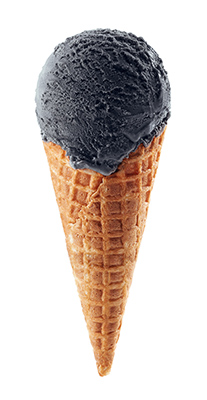We often get requests for a “good” or “true” black color. This is understandable even though black is often thought of being an unappetizing color for food. Still, the food industry is eclectic in its tastes, Halloween has just come and gone, and, as we all know, fads in color and appearance come and go. The challenge in these requests is to effectively deliver on performance.
In general, the US food industry has contented itself with blends of synthetic food colorants (FD&C’s) to fill this need. The general “pet peeve” has been that, at least in some circumstances, the black color appears to be more of a very dark green or blue rather than a “true” black. In many applications this isn’t an issue, but it can be noticeable in others.
With the consumer market focused on health and nutrition, synthetic ingredients are generally not favored, and natural products are in high demand. Things get complicated here because the EU permits the use of vegetable carbon black (E153) as a food grade colorant. It is quite effective in producing a true black color depending on the application and dosage. It is also permitted for use in Canada (1) and Mexico (2). However, at this writing, the FDA does not permit the use of vegetable carbon black in the US. It was identified some time ago as a potential carcinogen, and therefore it has not been included in the positive list of permitted color additives found in 21 CFR 73.
At The Color Lab we are sensitive to these issues and have been working with some success to deliver permitted, true black colors. We find that the formulation of such black colors is somewhat application-dependent, so we customize our approach to match application requirements.
Contact us today and let us assist you with your specific application needs.
- List of permitted Food Additives, Canada. ( List of Permitted Colouring Agents (Lists of Permitted Food Additives) – Canada.ca)
- List of permitted Food Additives, Mexico. (List of additives – Mexico (openfoodfacts.org)) Note that E153 (Carbon Black) is located about ¾ of the way down this rather long list.








